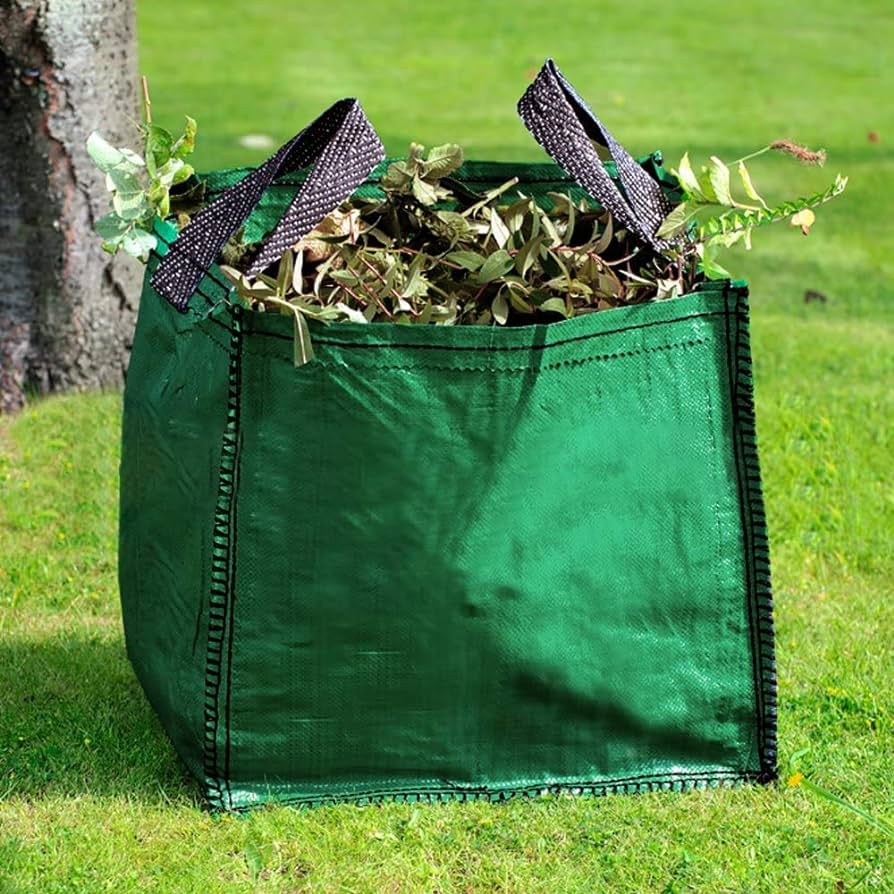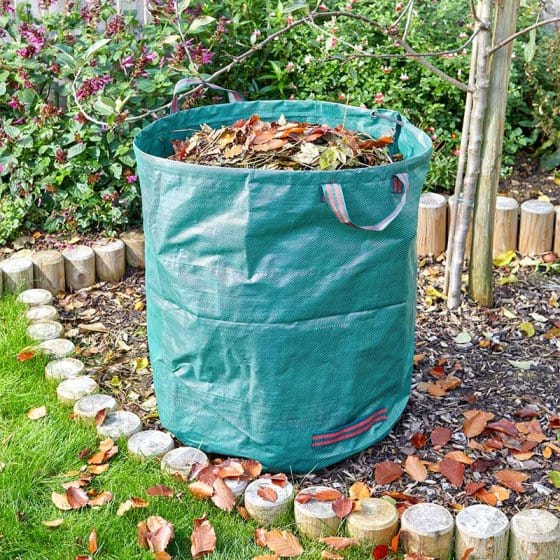I. Introduction
A. Embracing Eco-Conscious Gardening: Harmonizing with Nature
Modern gardening goes beyond cultivating beautiful blooms and nurturing delicious vegetables. Eco-conscious gardening practices strive to minimize environmental impact while promoting a healthy ecosystem. This philosophy extends to managing garden waste – the leaves, trimmings, and other organic debris generated by gardening activities. Garden waste bags offer a convenient solution, but choosing the right type and using them responsibly is crucial for sustainable gardening.
B. The Role of Garden Waste Bags: Managing Organic Waste Sustainably
Garden waste bags serve a valuable purpose in yard and garden maintenance. They help to:
- Maintain a Tidy Garden: Bags keep yards neat and free of scattered debris, enhancing the overall aesthetic.
- Facilitate Composting: They provide a convenient way to collect and transport yard waste for composting, transforming waste into nutrient-rich soil amendment.
- Curb Yard Waste Disposal: In areas with restrictions on burning yard waste, bags enable proper disposal through municipal collection programs.

Gone are the days of limited options for garden waste disposal. Today, gardeners can choose from a variety of garden waste bags, each with its own advantages and environmental impact.
A. Reusable Garden Waste Bags: A Sustainable Choice for Eco-Conscious Gardeners
Reusable garden waste bags are constructed from durable materials like canvas or polypropylene. These bags are:
- Eco-Friendly: They eliminate the need for disposable paper or plastic bags, reducing overall waste generation.
- Cost-Effective: The upfront investment is recovered through years of use, making them an economical choice.
- Sturdy and Versatile: They can handle heavy loads of yard waste and can be used for various garden tasks like collecting leaves, grass clippings, or prunings.
B. Biodegradable Garden Waste Bags: Embracing Nature’s Decomposition Cycle
Biodegradable garden waste bags are crafted from plant-based materials like corn starch or cellulose. These bags offer several benefits:
- Natural Decomposition: They break down naturally in compost piles or landfills, minimizing long-term environmental impact.
- Convenient for Composting: Biodegradable bags can be composted along with yard waste, eliminating the need to separate the bag material.
- Sturdy Enough for Most Needs: While not as durable as reusable bags, they can handle moderate loads of yard waste.
C. Compostable Garden Waste Bags: Transforming Waste into Nutrient-Rich Soil
Compostable garden waste bags represent the pinnacle of eco-friendly waste management. These bags are made from materials like PLA (polylactic acid) derived from corn starch and meet specific composting standards.
- Complete Breakdown: Compostable bags decompose entirely in properly managed compost bins, leaving behind no harmful residues.
- Seamless Composting Experience: Like biodegradable bags, they can be composted with yard waste, simplifying the process.
- Limited Availability and Higher Cost: Compostable bags may be more expensive and less readily available than other options.

III. Selecting the Ideal Garden Waste Bag: A Comprehensive Guide
Choosing the right garden waste bag requires considering several factors:
A. Assessing Garden Waste Needs: Determining the Right Size and Capacity
- Yard Size and Waste Volume: Larger gardens with substantial waste generation will benefit from larger capacity bags.
- Frequency of Use: For frequent waste collection, multiple smaller bags might be more manageable than a single large one.
- Type of Waste: Heavy materials like branches might require sturdier bags than those used for leaves or grass clippings.
B. Considering Durability and Construction:
- Reusable Bags: Look for strong stitching and handles that can withstand heavy loads.
- Biodegradable and Compostable Bags: Consider the bag’s thickness and ability to hold its form when filled.
C. Evaluating Material Options: Balancing Sustainability and Functionality
- Weigh the environmental benefits of reusable and biodegradable/compostable options against the convenience and durability of each type.
- Consider your budget and how often you plan to replace the bags.

IV. Utilizing Garden Waste Bags Effectively: Maximizing Efficiency and Minimizing Waste
A. Proper Filling and Closure:
- Don’t overload the bags: Overfilling can lead to tears and spills.
- Fill the bags evenly: This ensures proper weight distribution and prevents them from tipping over.
- Secure the closure tightly: This prevents windblown debris from escaping and keeps animals from getting inside.
B. Strategic Placement and Storage:
- Store bags in a cool, dry place: Protect them from direct sunlight and moisture to prevent degradation.
- Position waste bags strategically: Place them near areas where you generate the most yard waste for easy access.
C. Composting Techniques: Transforming Waste into Valuable Garden Amendments
For those opting for compostable or biodegradable bags, composting the bags along with the yard waste unlocks their full potential:
- Chop or shred yard waste: This speeds up decomposition in the compost pile.
- Maintain a proper balance of green and brown materials: Green materials (like grass clippings) provide nitrogen, while brown materials (like leaves) provide carbon, both essential for successful composting.
- Monitor moisture levels: The compost pile should be moist but not soggy. Turn the pile regularly to aerate it and promote decomposition.

V. Eco-Conscious Alternatives to Garden Waste Bags: Embracing Sustainability
While garden waste bags offer a convenient solution, several eco-conscious alternatives minimize waste generation:
A. Composting in Place: Utilizing Nature’s Decomposition Cycle
Composting directly in your garden eliminates the need for bags altogether. Techniques include:
- Sheet mulching: Layer cardboard or newspaper on top of garden beds to suppress weeds and gradually decompose, adding organic matter to the soil.
- Chop and drop: Chop leaves and prunings and leave them on the garden bed as mulch. Over time, they decompose and enrich the soil.
B. Mulching Techniques: Suppressing Weeds, Conserving Moisture, and Enhancing Soil Health
Using yard waste as mulch offers multiple benefits:
- Weed suppression: Mulch prevents weeds from germinating and establishing themselves.
- Moisture retention: Mulch helps retain moisture in the soil, reducing the need for frequent watering.
- Soil health improvement: Over time, mulch decomposes and adds organic matter to the soil, improving its structure and fertility.
C. Creative Reuse and Repurposing: Giving New Life to Old Materials
Get creative with leftover yard waste:
- Use branches as edging for garden beds.
- Chop woody prunings for kindling or fire pits.
- Create a brush pile to provide habitat for small animals.

VI. Environmental Impact of Garden Waste Bags: A Balanced Perspective
A. Assessing the Environmental Footprint of Different Bag Types
- Reusable bags: While eco-friendly, their production requires resources and energy.
- Biodegradable and compostable bags: They decompose, but the manufacturing process might still have an environmental impact.
- Paper or plastic bags: These traditional options are not sustainable and contribute to landfill waste.
B. Minimizing Waste Generation: Reducing the Need for Garden Waste Bags
- Practice proper pruning techniques: Minimize unnecessary trimming to reduce waste.
- Compost kitchen scraps along with yard waste: This diverts food waste from landfills and enriches your compost pile.
- Consider using a chipper/shredder: Shredded yard waste can be used directly as mulch or composted more efficiently.
C. Sustainable Disposal Practices: Ensuring Proper End-of-Life Management
- For reusable bags: Wash them regularly and replace them only when necessary.
- For biodegradable and compostable bags: Ensure your compost pile reaches the necessary temperatures for complete breakdown. If unsure, dispose of them in designated compostable waste collection programs if available.
- For paper or plastic bags: Check with your local municipality to see if they accept them in recycling programs. If not, avoid using them altogether.
VII. Conclusion
A. Embracing Eco-Conscious Gardening Practices: A Path Towards Sustainable Gardening
Sustainable gardening practices prioritize environmental well-being. By choosing the right garden waste bags, utilizing them effectively, and exploring alternative waste management solutions, gardeners can cultivate beautiful landscapes while minimizing their environmental footprint.
B. The Enduring Significance of Garden Waste Bags: Managing Waste Responsibly
Garden waste bags play a valuable role in maintaining a tidy garden and managing yard waste responsibly. By making informed choices and adopting sustainable practices, gardeners can ensure that their waste management solutions align with their eco-conscious gardening philosophy.
VIII. Additional Resources
A. Online Resources for Eco-Conscious Gardening: Websites and blogs dedicated to sustainable gardening practices. B. Sustainable Gardening Organizations and Communities: Local gardening clubs or organizations promoting eco-friendly gardening techniques. C. Local Composting Programs and Initiatives: Municipal or community composting programs offering guidance and resources for composting yard waste.